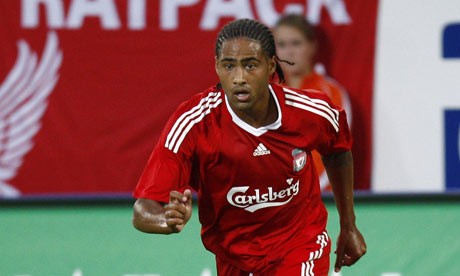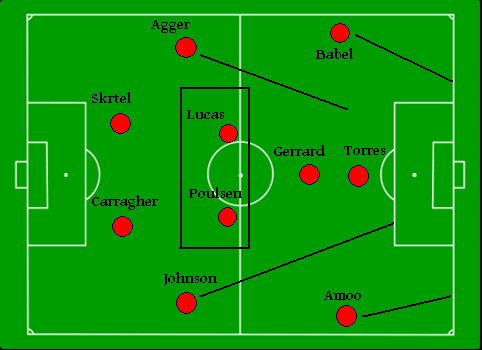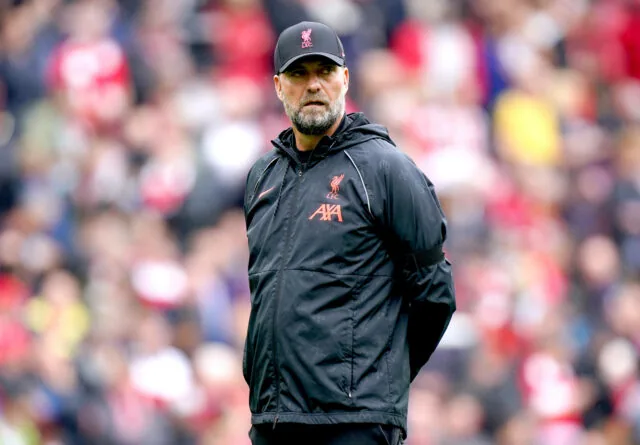In todays format fullbacks are deadly important, apparently – it was Brain Clough wasn’t it, who said that fullbacks were the most important player on the pitch because of the space they would get when moving into the final third. And certainly the modern game attacking fullbacks are seen as a must have – Evra, Alves, Maicon, Cole…
Nowadays we look at fullbacks as needing attacking flair – that was the difference between Johnson and Arbeloa for Liverpool, between having a more conservative player and one who at his best owns entire flanks.
But maybe it’s just me who sees the modern fullback as not the most efficient.
Lets look for example at Emiliano Insua, all but departed from Liverpool, on loan to Galatasaray. Last season he got something like six assists and a goal – which actually for a fullback in England is very, very impressive indeed – better then most of the big four fullbacks. Combined. But then that good work in the final third was cancelled out by his defensive inadequacies in a season in which not one game did we look entirely secure at the back.
This is inevitably the same of alot of fullbacks – their attacking prowess just doesn’t give enough of note to justify the vast space they leave at the back. And lets be honest here, it’s not an easy life being a fullback. You need to be able to defend well, them bomb forward. Then you probably need to beat someone, then put in a good cross. All to get a paltry chance. Only the best can truely pull off that sort of role and allow their team to profit from it. The rest are as much a problem for their team as an asset.
Because in a time when wingers are expected to cut inside fullbacks are expected to deliver width and thus do the hardest job on the pitch – to deliver expertly in both attack and defence. There aren’t many out there capable of making their marauding worthwhile. Maybe even just the few above. Maybe not even some of them.

So arguably the most important remaining question in all of football is how to get the most use of your fullbacks. And not to be arrogant, but I think I have the answer for you. Don’t send fullbacks out wide, get them into the box.
Of course the entire teams tactics would have to change around this, but the potential benefits are staggering.
Fullbacks getting into the penalty area can cause utter carnage. Take Kieron Gibbs for example who against Hungary made runs inside of Ashley Young. This causes a number of problems.
- It leaves the defenders with another body to track, and it also leaves the winger in a position they don’t want to be in. Wingers can do alright tracking back along the wing, but when they have to track into the centre a whole new series of problems arises – they have to play the central defender rather then a makeshift fullback.
- Wingers aren’t of course trained for that – your attacking wingback can get behind the opposition into the penalty area and his crosses are more likely to find a target, suck the opposition deeper and generally allow a team to get on top of their opponent.
- It’s another body in the area, turning your two strikers into three, or taking your Gerrard, Kuyt and Torres and adding Johnson running from deep. Take for example someone like Jolean Lescott – an able defender, powerful in the air and good at attacking the area, he would be a perfect wingback for this scenario, able to defend and attack. Scoring or assisting from inside the area afterall, is far easier then delivering that pinpoint cross onto Torres’ head from 20/25 yards away.
- Your wingbacks going inside allows your winger to be a proper winger, rather then a winger come striker. Players like Ashley Young, or Walcott even become far more dangerous in this type of scenario – having simply to beat the man and deliver the cross not to a single or two men but to three or four, thus simply having the play the ball into a dangerous position and watching the chaos it causes. You wingers then can stay extremely wide while still having the nessecary players in the area.
- Hell, your wingbacks wouldn’t even have to do that. If you were to play a 4-4-2 formation for example (or 4-4-1-1, whichever way you look at it), you could have two advanced strikers and the wingers, plus two central midfielders who act the destroyer and playmaker. The purpose of this? Again it’s to allow the wingback to slip into the hole between midfield and defence from deep – supplying the two attackers neither of which has had to drop off to get to the ball.
- This would also, oddly, add extra security to your defence. Having these fullbacks slip into dangerous positions in the centre of the pitch allows midfielders to dictate from deeper and hold the opposition at arms length, dominating and controlling the game while still having players get into dangerous positions. If the ball is lost one of the shield midfielders can slip into the space left by a wingback while one is still holding the space in front of the defence.
So if you were to take the Liverpool team as it stands, pick the players for the roles you could end up with something like this.

Wheather you consider those players good enough for the role is moot, so bear with me – the players are picked for their roles. You have Skrtel and Carragher playing their usual defensive roles. Lucas and Poulsen would seek to control the ball and thus possesion, trying to own the middle of the park. Gerrard could do his usual – play in the hole or get close to Torres as a second striker.
So back to the diagram above, in the fullback positions we have Agger who could move up into midfield to allow Lucas to move further up the field, or even get into the hole, take a shot or get into the area, depending on where Gerrard has moved.
Johnson can get inside the edges of the penalty box and provide an alternative outlet, take shots – as a result, if all were to go to plan, you would have Amoo say, rip past his wingback, and have the option of Gerrard, Torres, Johnson and Babel all in the box to cross to. While still having your midfield shield and three defenders pressed high up the pitch to keep the opposition boxed in. In this way, wingbacks can not only really intimidate the opposition but also get more goals and assists as a result of being in the box.
So to conclude, were we to have wingbacks trained not to get up the wings, but get into the box they could cause alot more problems then they do now. Indeed, there is a range of possibilities for a wingback right across the final third, while keeping your defensive spine in shape to resist counterattack.
Maybe the future of the fullback isn’t attacking from wide, but adding more prescence in the middle of the pitch. Perhaps then an even more useful and powerful form of fullback can be realised.
Follow me on twitter.
Add Sportslens to your Google News Feed!






